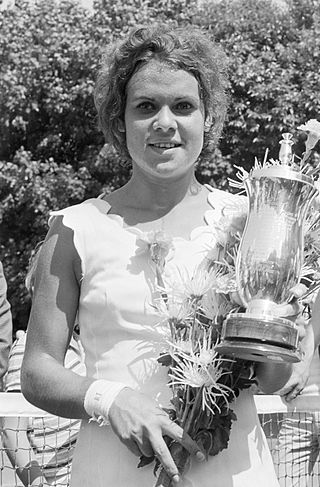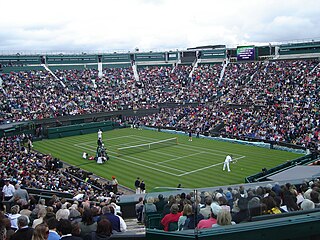Related Research Articles

Evonne Fay Goolagong Cawley is an Australian former world No. 1 tennis player. Goolagong was one of the world's leading players in the 1970s and early 1980s.

Ilie Theodoriu Năstase is a former World No. 1 Romanian tennis player. He was ranked world No. 1 in singles from 23 August 1973 to 2 June 1974, and was the first man to hold the top position on the computerized ATP rankings. Năstase is one of the 10 players in history who have won over 100 total ATP titles, with 64 in singles and 45 in doubles.

The International Tennis Federation (ITF) is the governing body of world tennis, wheelchair tennis, and beach tennis. It was founded in 1913 as the International Lawn Tennis Federation by twelve national tennis associations. As of 2016, there are 211 national and six regional associations that make up the ITF's membership.

Kerry Melville Reid is a former professional tennis player from Australia. During her 17-year career, Reid won one Grand Slam singles title and 26 other singles titles and was the runner-up in 40 singles tournaments. Reid was included in the year-end world top-ten rankings for 12 consecutive years (1968–1979). She won at least one tournament annually from 1966 through 1979, except for 1975. Her career-high ranking was world No. 5 in 1971, behind Margaret Court, Billie Jean King, Evonne Goolagong, and Rosie Casals.

Patrick Proisy is a French former professional tennis player best remembered for reaching the final of the French Open in 1972. He added to that one more final and singles titles in Hilversum, 1977 and Perth, 1972. Proisy reached a career-high singles ranking of world No. 16 in October 1972.

The racket sport traditionally named lawn tennis, invented in Birmingham, England now commonly known simply as tennis, is the direct descendant of what is now denoted real tennis or royal tennis, which continues to be played today as a separate sport with more complex rules. Most rules of (lawn) tennis derive from this precursor and it is reasonable to see both sports as variations of the same game. Most historians believe that tennis was originated in the monastic cloisters in northern France in the 12th century, but the ball was then struck with the palm of the hand; hence, the name jeu de paume. It was not until the 16th century that rackets came into use, and the game began to be called "tennis." It was popular in England and France, and Henry VIII of England was a big fan of the game, now referred to as real tennis.
Mariaan de Swardt is a former professional tennis player from South Africa, who was active from 1988 to 2001. She twice represented her native country at the Summer Olympics, in 1992 and 1996, and was a member of the South Africa Fed Cup team in 1992 and from 1994 to 1997. In 2006, de Swardt became a U.S. citizen.

Sport has a very significant role in South African culture. The three most popular mainstream sports in the country — soccer, rugby, and cricket — reflect the country's early British colonial influence. South Africa was absent from international sport for most of the apartheid era due to sanctions, but started competing globally after the end of apartheid. South Africa is among a very few countries which have participated in world cups of all four major sports — cricket, Soccer, rugby union and rugby league. England, Ireland, Scotland, New Zealand, and Australia are among other such nations. South Africa has hosted the 1995 Rugby World Cup, 2003 ICC Cricket World Cup and 2007 ICC World Twenty20, and 2010 FIFA World Cup.
Alan Abraham Segal was a South African tennis player.
South Africa under apartheid was subjected to a variety of international boycotts, including on sporting contacts. There was some debate about whether the aim of the boycott was to oppose segregation in sport or apartheid in general, with the latter view prevailing in later decades. While the National Party introduced apartheid in 1948, it added sport-specific restrictions from the late 1950s, on interracial sport within South Africa and international travel by nonwhite athletes. The international federations (IFs) governing various sports began to sanction South Africa, both in response to the new restrictions and in reflection of the broader anti-racism of national federations in newly independent postcolonial states. By the early 1970s, South African national teams were excluded from most Olympic sports, although South Africans competed in individual events in some, mainly professional, sports through the 1980s. Although from the mid-1970s the National Party relaxed the application of segregation provisions in relation to sport, this failed to alleviate the boycott, which continued until the end of apartheid.

Raven Klaasen is a South African professional tennis player who specialises in doubles.

Netball is one of the most popular women's participation sports in South Africa. The sport is also played by a large number of men. It exists in a culture where sport plays an important public and social part of life. The history of South Africa's netball involvement mirrors that of other sports played in the country like rugby union. During the apartheid era, there were many netball facilities available for whites to use, and fewer for people from other race groups. Funding issues and gender issues did not help bridge this gap.

Sydney University Boat Club is the rowing club in Sydney, Australia with the oldest charter having been formed in 1860 by the founders of the University of Sydney. It has had a boatshed presence in various locations on Sydney Harbour since 1886, excepting between 1941 and 1966. A varsity and recreational club during most of its history, the Boat Club has since the 1990s had a focus on its high performance and elite rowing programs. Supported by the University's Sports Union the Club has developed an increasing number of Olympic representative oarsmen and women in the new millennium with club members rowing in twenty-two seats in those Australian Olympic crews who represented between Athens 2004 and Tokyo 2021.
Women's sport in New South Wales was first organised statewide in 1933. Coverage of women's sport in the state media lags behind that of men. Discrimination based on gender is allowed for sport in the state. The University of Sydney has women's sport history dating back to the 1890s.
Netball in Kenya is primarily played by girls. The Kenya Netball Association changed its name to its current one in 1966, and became the first African nation to join the International Federation of Netball Associations. Club netball is played in the country. The national team has qualified for the Commonwealth Games.
Ilze Hattingh is a South African former professional tennis player.
Katarzyna Teodorowicz-Lisowska is a former professional tennis player from Poland. She was born Katarzyna Teodorowicz.
Esmé Emmanuel Berg is a former professional tennis player from South Africa. Emmanuel was the girls' singles champion at the 1965 French Championships. She won a doubles gold medal at the 1965 Maccabiah Games in Israel. Her best performance at Wimbledon came in 1972 when she was a doubles quarterfinalist, partnering Ceci Martinez.
Monica Giorgi is an Italian former professional tennis player.
Judith Dibar-Gohn is a Romanian former tennis player. She was known as Judith Dibar before marriage.
References
- 1 2 3 Archer & Bouillon 1982, p. 102.
- 1 2 3 Archer & Bouillon 1982, p. 101.
- ↑ Sherington & Georgakis 2008, p. 225.
- ↑ Bale 1991, p. 58.
- ↑ Djata 2008, p. 84.